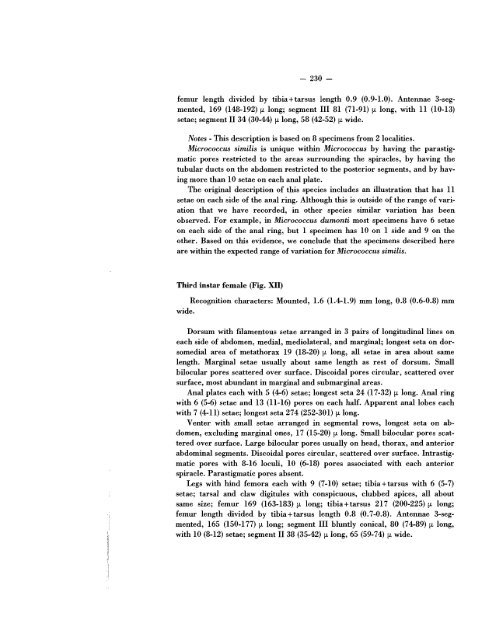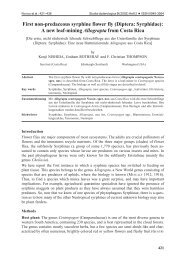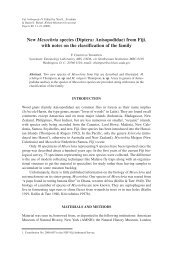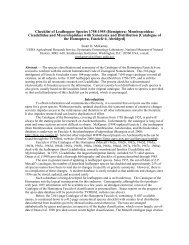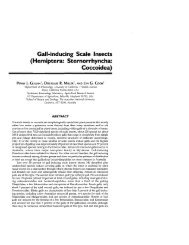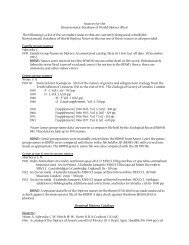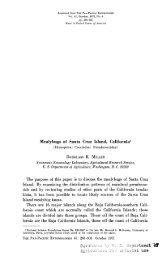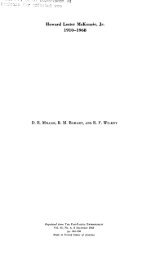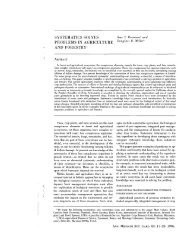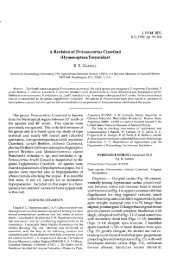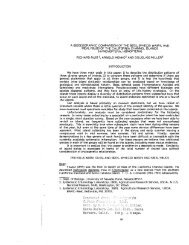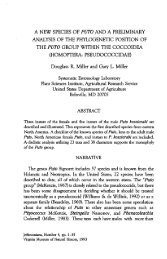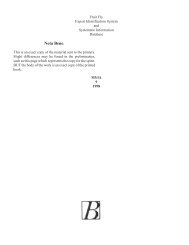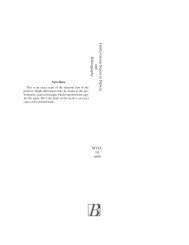Systematic revision of the Family Micrococcidae (Homoptera ...
Systematic revision of the Family Micrococcidae (Homoptera ...
Systematic revision of the Family Micrococcidae (Homoptera ...
You also want an ePaper? Increase the reach of your titles
YUMPU automatically turns print PDFs into web optimized ePapers that Google loves.
- 230 <br />
femur length divided by tibia +tarsus length 0.9 (0.9-1.0). Antennae 3-segmented,<br />
169 (148-192) fJ. long; segment III 81 (71-91) fJ. long, with 11 (10-13)<br />
setae; segment II 34 (30-44) fJ. long, 58 (42-52) fJ. wide.<br />
Notes - This description is based on 8 specimens from 2 localities.<br />
Micrococcus similis is unique within Micrococcus by having <strong>the</strong> parastigmatic<br />
pores restricted to <strong>the</strong> areas surrounding <strong>the</strong> spiracles, by having <strong>the</strong><br />
tubular ducts on <strong>the</strong> abdomen restricted to <strong>the</strong> posterior segments, and by having<br />
more than 10 setae on each anal plate.<br />
The original description <strong>of</strong> this species includes an illustration that has 11<br />
setae on each side <strong>of</strong> <strong>the</strong> anal ring. Although this is outside <strong>of</strong> <strong>the</strong> range <strong>of</strong> variation<br />
that we have recorded, in o<strong>the</strong>r species similar variation has been<br />
observed. For example, in Micrococcus dumonti most specimens have 6 setae<br />
on each side <strong>of</strong> <strong>the</strong> anal ring, but 1 specimen has 10 on 1 side and 9 on <strong>the</strong><br />
o<strong>the</strong>r. Based on this evidence, we conclude that <strong>the</strong> specimens described here<br />
are within <strong>the</strong> expected range <strong>of</strong> variation for Micrococcus similis.<br />
Third instar female (Fig. XII)<br />
Recognition characters: Mounted, 1.6 (1.4-1.9) mm long, 0.8 (0.6-0.8) mm<br />
wide.<br />
Dorsum with filamentous setae arranged in 3 pairs <strong>of</strong> longitudinal lines on<br />
each side <strong>of</strong> abdomen, medial, mediolateral, and marginal; longest seta on dorsomedial<br />
area <strong>of</strong> metathorax 19 (18-20) fJ. long, all setae in area about same<br />
length. Marginal setae usually about same length as rest <strong>of</strong> dorsum. Small<br />
bilocular pores scattered over surface. Discoidal pores circular, scattered over<br />
surface, most abundant in marginal and submarginal areas.<br />
Anal plates each with 5 (4-6) setae; longest seta 24 (17-32) fJ. long. Anal ring<br />
with 6 (5-6) setae and 13 (11-16) pores on each half. Apparent anal lobes each<br />
with 7 (4-11) setae; longest seta 274 (252-301) fJ. long.<br />
Venter with small setae arranged in segmental rows, longest seta on abdomen,<br />
excluding marginal ones, 17 (15-20) fJ. long. Small bilocular pores scattered<br />
over surface. Large bilocular pores usually on head, thorax, and anterior<br />
abdominal segments. Discoidal pores circular, scattered over surface. Intrastigmatic<br />
pores with 8-16 loculi, 10 (6-18) pores associated with each anterior<br />
spiracle. Parastigmatic pores absent.<br />
Legs with hind femora each with 9 (7-10) setae; tibia +tarsus with 6 (5-7)<br />
setae; tarsal and claw digitules with conspicuous, clubbed apices, all about<br />
same size; femur 169 (163-183) fJ. long; tibia +tarsus 217 (200-225) fJ. long;<br />
femur length divided by tibia +tarsus length 0.8 (0.7-0.8). Antennae 3-segmented,<br />
165 (150-177) fJ. long; segment III bluntly conical, 80 (74-89) fJ. long,<br />
with 10 (8-12) setae; segment II 38 (35-42) fJ. long, 65 (59-74) fJ. wide.


